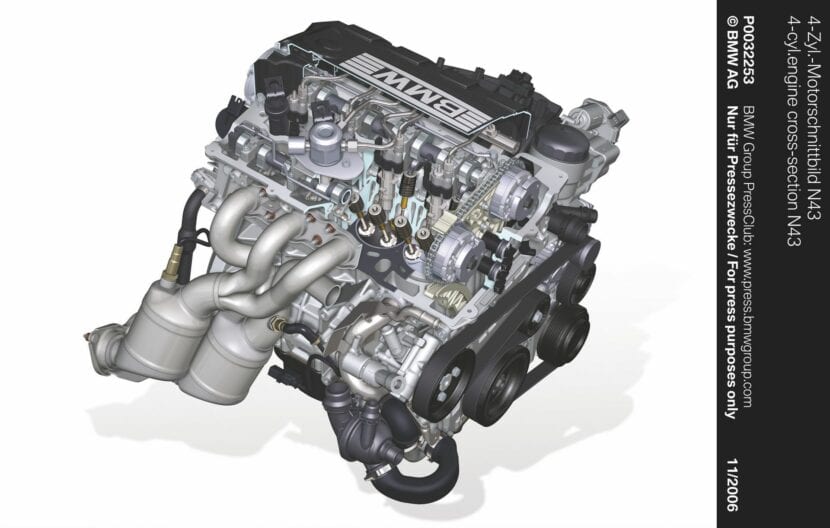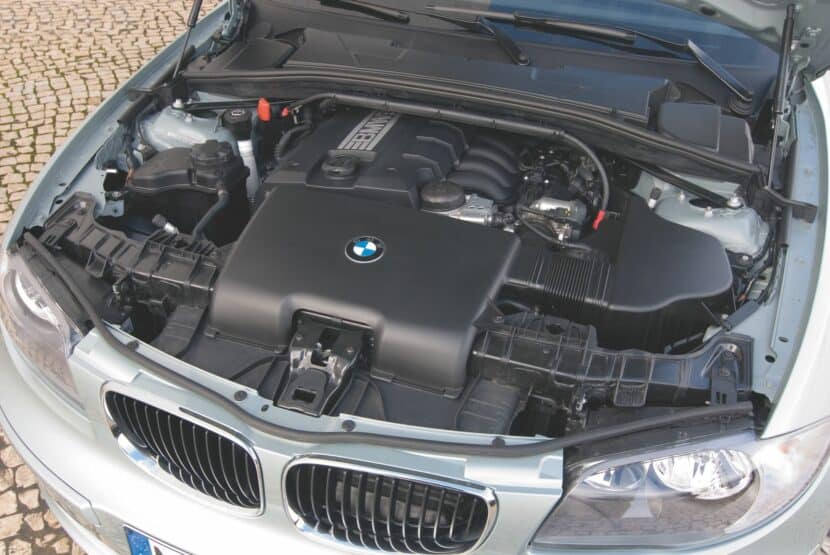Not seen in North America – for that, you can be eternally grateful…
The BMW N43 engine is a technological masterpiece. Delivering 170 bhp without a turbocharger in a 2-liter four-cylinder engine was quite an achievement. BMW designed this engine with one arm behind their back – facing ever stricter emissions regulations on one hand, and the challenge of making an engine tractable and economical on the other.
The N43 was impressive for its time in 2007, featuring an all-alloy construction with a ladder-type crankcase, where the main bearing caps are built into a ‘ladder’ type frame for serious strength. It had Double Vanos cam timing, 16 valves with chain-driven camshafts, but lacked Valvetronic – BMW’s clever idea that altered the lift of the inlet valves to adjust engine speed and load, but was incompatible with direct injection.
The timing chain setup used a cassette-type chain assembly, lowered down into the engine with the cylinder head fitted as a complete unit with the chain, the plastic guide rail, and pivoting tensioner blade, crank sprocket, and the two Vanos units. Interestingly, the crank had no nose onto which the crank sprocket would fit, and the end bolt was tightened to 300nm, relying on the torque of the bolt to keep it together – a design that works well. Similarly, the Vanos units weren’t keyed to the camshafts either, and stretch bolts were used, activated by oil pressure and controlled by electronic oil pressure solenoids.
The generator and AC pump ran off one auxiliary belt, and to save fuel and help emissions, an electric water pump and electric power steering rack were used, with a camshaft-driven brake servo vacuum pump. The oil pump is integral with the balance shaft unit in the sump, chain-driven from the crank. An ECU-controlled thermostat regulates engine temperature, and for ultimate efficiency, the oil pressure is regulated by an electronic solenoid in the main oilway to provide the engine with just the oil pressure it needs, reducing the load on the pump.
There are two engine capacities used on the N43: a 1.6-liter unit for the 116i and 316i, and a 2-liter in the later 116i, 118i, 120i, 318i, 320i twins, and an E60 520i. The main change for the N43 over the N46, from which it was derived, was the introduction of direct injection. This required a new head casting to accept the big metal Piezo injectors, as well as a camshaft lobe-operated high-pressure fuel pump. EGR (exhaust gas recirculation) was used, along with a set of exhaust gas sensors. In addition to the three Lambda probes, there’s also a NoX (nitrogen oxide) sensor.
What about PIEZO?
No, it’s not an Italian dish, although these injectors were made in the VDO Siemens Italian factory. These injectors contain Piezo crystals that expand and contract when given an electrical pulse, allowing for an incredibly fast and accurate fuel spray. These injectors are astonishing and contribute to the engine’s power output of 170 bhp.
What Goes Wrong?
The N43 was beset with misfires and running problems ten or fifteen years ago. Troubled Piezo injectors, as well as failing coil packs, made many an N43 owner’s life a nightmare. Of course, these issues can be fixed, but at a price – new injectors are around £400 each, plus fitting and coding, and you’d hope you don’t need to replace the other three since they cannot be reconditioned.
The timing chain has a reputation, but it’s more the chain guides than the chain itself – actual chain breakage is rare. If the plastic guides have broken up, the oil pan will need to be dropped to get the bits out. Bits of chain guide blocking the oil pick-up strainer are probably the biggest killer of N43 motors. N43 Vanos units are better than the older N46 ones and don’t fail that often.
The N43 had a poor reputation for being a misfire nightmare. It’s not BMW’s fault either because they were forced down the direct injection route by Euro emissions laws. The original Piezo injectors have mostly been replaced with new ones by now. NoX sensors can fail and cause the car to run massively rich, and used ones are very rare. A NoX emulator from Bimmerprofs is a better idea as they can be tuned to the engine and not vice versa. The three Lambda probes are reliable, however.
The N46 can be smoky in old age, but the N43 seems much better. The brake vacuum pump can fail, meaning the servo won’t work (heavy brakes), and it’s not so easy to replace. Low oil pressure can be caused by three things – worn balance shaft bearings, a faulty pressure solenoid, or a faulty thermostat resulting in the engine running too hot.
Is The N43 Reliable?
Overall? The N43 is a risky proposition, and the N46 – particularly the later versions – is a better idea. On one hand, it performs well and can achieve 40 mpg with care, but so do many other cars. Reliability is certainly an issue, but these are now of a value low enough not to worry too much. If nothing else, a good one is a fascinating engine… it’s just ironic that this and the direct injection N53 straight six were denied access into the US.”


